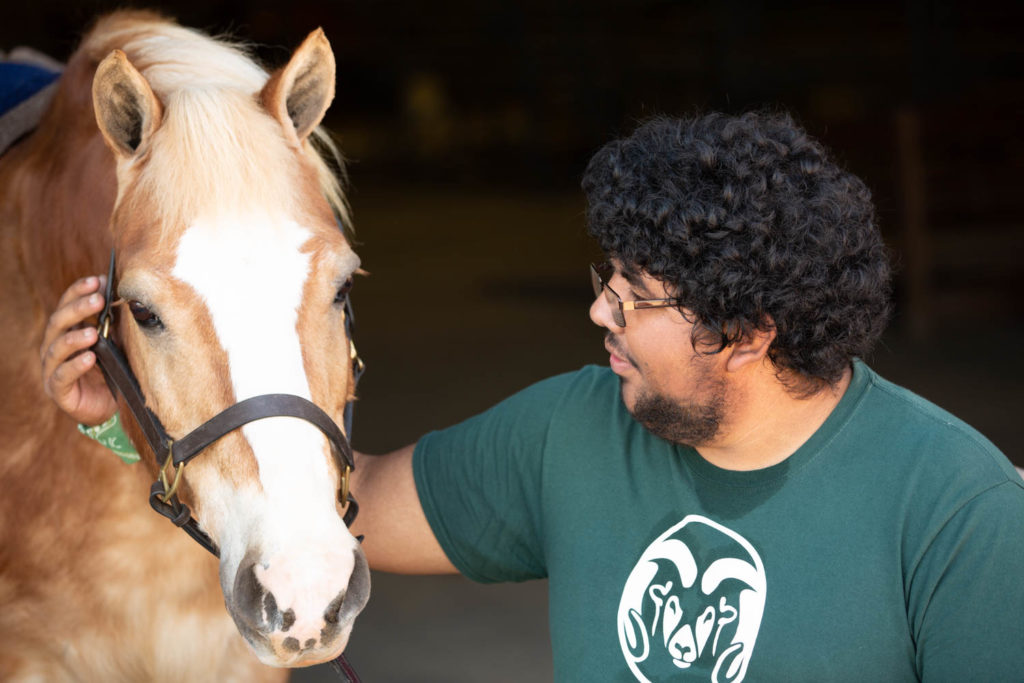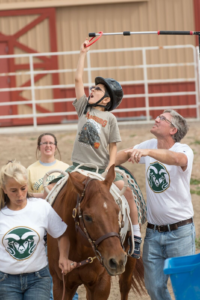
Temple Grandin, Colorado State University professor and one of the most influential individuals with autism, attributes much of her success to growing up around horses. In fact, one of the research missions of CSU’s Temple Grandin Equine Center is to study occupational therapy in an equine environment for youth with autism.
Researchers in the CSU Departments of Animal Sciences, Occupational Therapy, and Human Development and Family Studies are studying how equine interventions benefit youth with autism.
The benefits
At therapeutic riding centers across the United States, individuals with autism are the population served most often. As many as 10 percent of youth with autism participate in equine-assisted services. However, research supporting the benefits of equine-assisted services for youth with autism is limited.
A recent CSU pilot study aimed to develop and evaluate occupational therapy in an equine environment for youth with autism has found preliminary evidence that a screening, evaluation, and intervention protocol of occupational therapy in an equine environment can improve performance on individualized goals, social functioning, and behavioral regulation for some youth with autism.
Participating in activities with horses can increase social engagement for a population that doesn’t often engage in social situations. The inclusion of horses in therapy provides an ideal context to teach social skills.
 “The theoretical rationale for why it is beneficial to include horses in occupational therapy for youth with autism has been under-developed, said Caiti Peters, a postdoctoral researcher in the Department of Animal Sciences and associate research coordinator for the study. “Part of our goal with this research is to better develop this theoretical rationale.”
“The theoretical rationale for why it is beneficial to include horses in occupational therapy for youth with autism has been under-developed, said Caiti Peters, a postdoctoral researcher in the Department of Animal Sciences and associate research coordinator for the study. “Part of our goal with this research is to better develop this theoretical rationale.”
Peters earned her master’s degree in occupational therapy and Ph.D. in occupation and rehabilitation science from CSU’s Department of Occupational Therapy, where she worked with Wendy Wood, an occupational therapy professor who serves as research director for the Temple Grandin Equine Center. Peters also collaborates with Susan Hepburn, professor in the Department of Human Development and Family Studies. Hepburn is an autism researcher who was on Peters’ doctoral committee and who is helping Peters incorporate intervention science into her protocols.
Peters explained that youth with autism may benefit from occupational therapy in an equine environment because many youth are motivated to engage, since activities with horses are fun and interesting. Research shows that youth with autism are more social when they are in the presence of animals.
Occupational therapy in an equine environment also helps with self-regulation. These youth are often understimulated or overstimulated, which makes it difficult for them to engage and learn. The movement of horses can help youth with autism to achieve a calm-alert state optimal for learning.
The study
The study conducted by the Temple Grandin Equine Center followed a framework developed by the National Institute of Mental Health that outlines a phased, developmental research approach for developing and evaluating an intervention for youth with autism. Support for this research was provided by the Carl and Caroline Swanson Foundation. The intervention was delivered at Hearts and Horses Therapeutic Riding Center.
 In the study, youth participated in the entire occupational therapy process, starting with an evaluation to determine the current level of functioning and individual goals.
In the study, youth participated in the entire occupational therapy process, starting with an evaluation to determine the current level of functioning and individual goals.
The occupational therapist designed intervention activities with the horse specific to that participant in order to address their individual goal. If one participant was working on turn-taking, the occupational therapist provided direct instruction on the new social skill, support as needed, feedback, and positive reinforcement.
Changes were also made to the type of equine movement to help the participant attain an optimal state of stimulation for learning. The different types of equine movement included different gaits, speeds, and patterns.
The occupational therapist also monitored progress and continually redesigned activities to offer the correct challenge.
“The attention of the therapists combined with the relaxation/distraction created by the horse allowed [my son] to take in new information that he would not have otherwise absorbed,” said a research participant.
The recently published pilot study represents Phase 1 of the framework, which led to a Phase 2 study, funded by the Horses and Humans Research Foundation. Phase 2 focused on the creation of an intervention manual, and the assessment of the feasibility, accessibility and efficacy of the new intervention.
Phase 2 of the study found that the intervention and evaluation protocol was feasible to implement and acceptable to both parents and therapists. However, the study highlighted the need for further development work needed to prepare for a Phase 3 trial.
A recently funded study by the Human Animal-Bond in Colorado will pilot an enhanced protocol to evaluate occupational therapy in an equine environment. The study will establish an interdisciplinary team that will collaborate to apply for grant funding to conduct the Phase 3 trial.
The Departments of Human Development and Family Studies and Occupational Therapy are part of CSU’s College of Health and Human Sciences. The Department of Animal Sciences is part of CSU’s College of Agricultural Sciences.